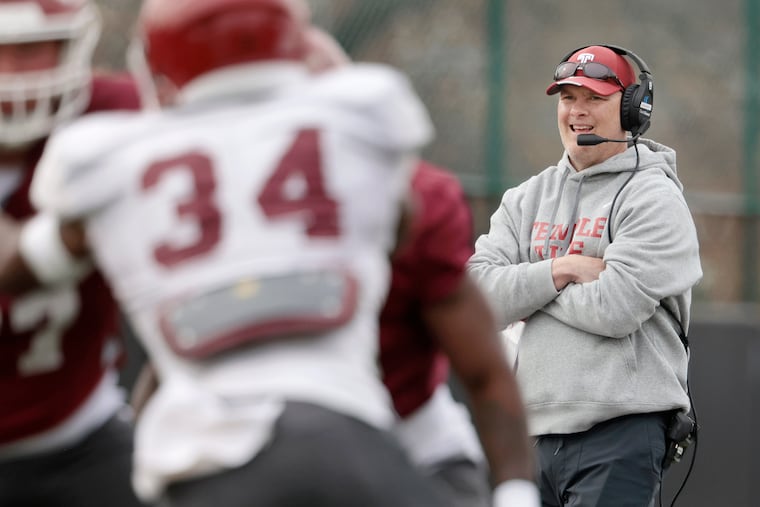Temple football coaches on the creativity needed to navigate the NCAA’s transfer portal
From creating a culture that sticks to looking outside the norm, here’s how two coaches say they maneuver through the carousel of the portal.

Larry Knight has come to grips with it.
Chris Wiesehan has tasked himself with trying to find ways to mitigate it.
When it comes to the revolving door that the NCAA transfer portal has made college athletics, it’s hard for teams that aren’t situated in a Power Five conference to keep top talent on their roster.
Long gone are the days of programs recruiting and developing talent that stays all four years. The transfer portal has allowed student-athletes to throw their names in the ring in a move to a bigger school — and for many, a big payday.
So, in the case of Knight and Wiesehan, both top position coaches within Temple’s ever-changing football program, it’s been leaning on existing players to help create a culture that builds bonds and, hopefully, continuity.
“The portal changed the game,” said Knight during a recent press conference at Temple.
Knight, who returned to the Owls in the offseason as their new defensive line coach after a three-year run at Georgia Tech, is no stranger to how the transfer portal can fracture a team. But at the same time, it’s also a new reality of the rapidly changing landscape of college sports.
“The way I see it, it’s kind of one of those situations where it is what it is. All I can do is try and develop great relationships with my guys and try to coach them hard, but also treat them like men so they feel respected at the same time. But at the end of the day, if somebody doesn’t want to be somewhere, it is what it is. So that’s why you as a coach, you’re always supposed to be recruiting anyway.”
» READ MORE: Temple awards single-digit jerseys to quarterback E.J. Warner, eight others
Wiesehan shared a similar philosophy, but noted that in addition to trying to woo top prep talent and entice players in the portal, there’s a whole subset of players least talked about.
The eager, hungry, and hopeful world of junior college talent.
“We are a developmental program, first and foremost,” Wiesehan said. “We are developing these men into leaders and leaders come from all over. If you look at the numbers and what people are getting paid [with their name, image, and likeness], it’s really a challenging spot. So we look at and utilize the junior colleges, which are filled right now because those kids are getting passed over a lot for the portal kids.”
Thinking outside the usual modes and getting creative is what could make the difference for smaller non-power conference programs to make a splash and not get decimated by the portal. Even as you read this, there are conferences, commissioners, and coaches pleading for oversight to as high up as Congress, but little has been done to stop the rampant flow of athletes entering and exiting programs.
Temple has reaped the benefits of the portal, too. Just this offseason, the Owls brought in 11 players from the NCAA transfer portal, according to 24/7 Sports, which tracks player movement. Many of them came from those top conferences to the benefit of coaches like Knight, who was able to grab defensive talent in former University of Miami lineman Allan Haye and Georgia Tech’s K.J. Miles, who had a relationship with Knight.
So what’s the plan to keep guys like that here for the long haul while developing them and their talents to fit your program?
“That’s a good question,” Knight said. “I think it’s more so about the culture in the room because I haven’t seen a situation where an entire room leaves. You’re instilling values that when a newcomer does arrive, the guys that have been there can help bring them along, one by one, teaching them what they need to learn at the same time. And I think that’s where the continuity comes from.”
The portal has only added to the hysteria of recruiting players. Whether it be a blue-chip recruit or a grad transfer, the song and dance to bring talent to a program is timeless. What has changed, however, is how coaches approach it — and the creativity to see it through for a net positive.
“I think winning comes down to having great leaders and great teammates and having a superior culture if you want to win generationally,” Wiesehan said. “[When it comes to the portal], if you can plug a guy here and he can help the program, he’s got high character, then that’s good. But you need to make sure that you kick the tires. You have to know exactly what you’re getting because I would sacrifice talent for culture at Temple and expect to have long-term success.”